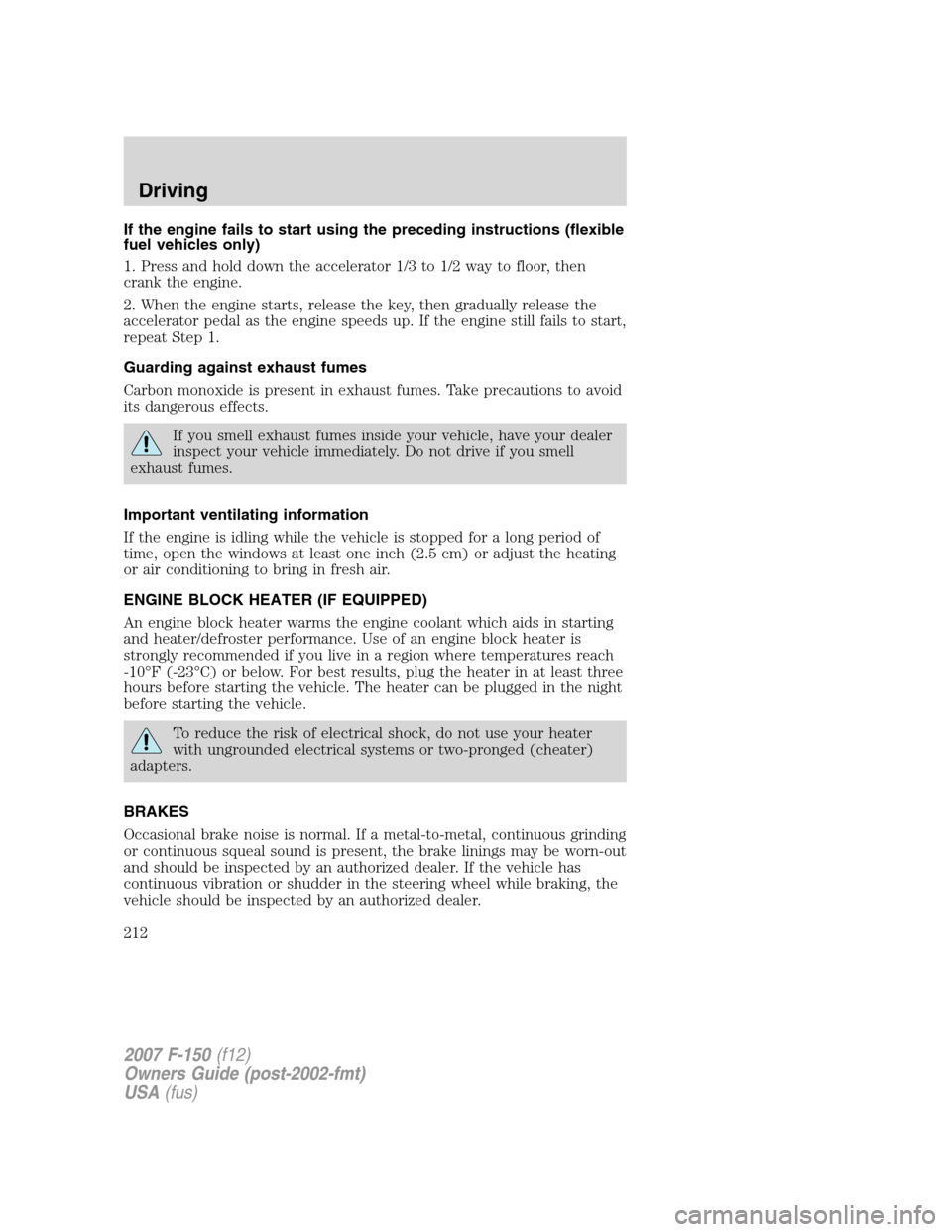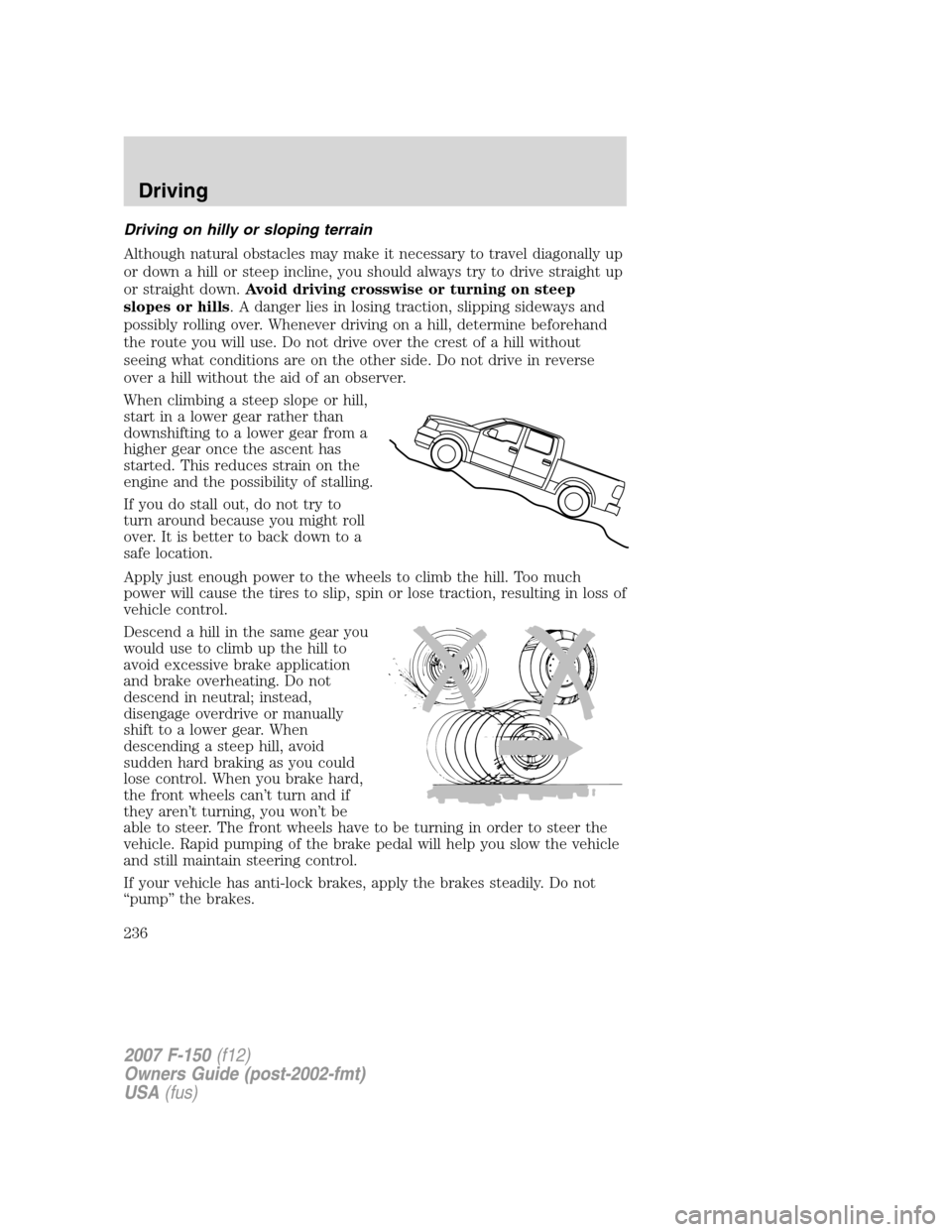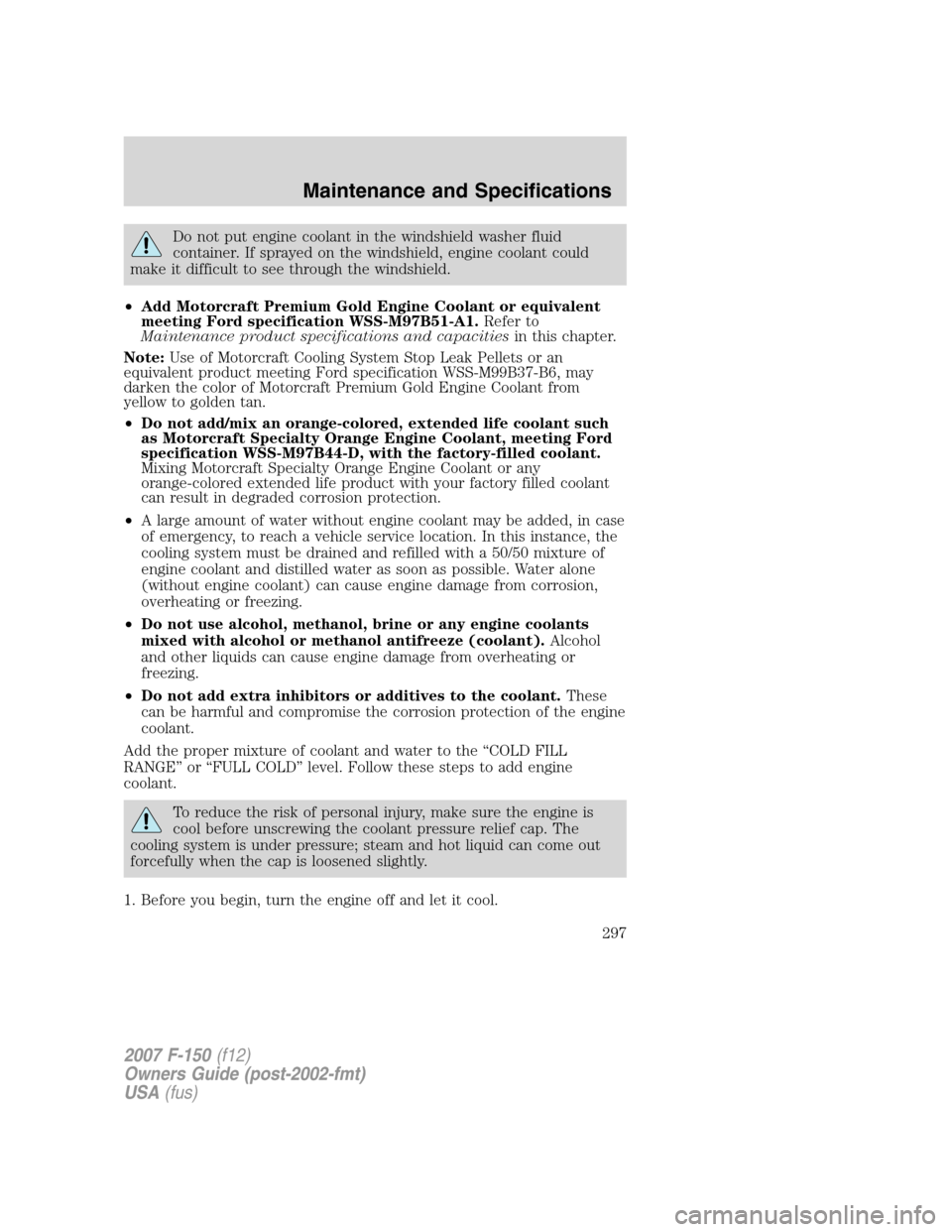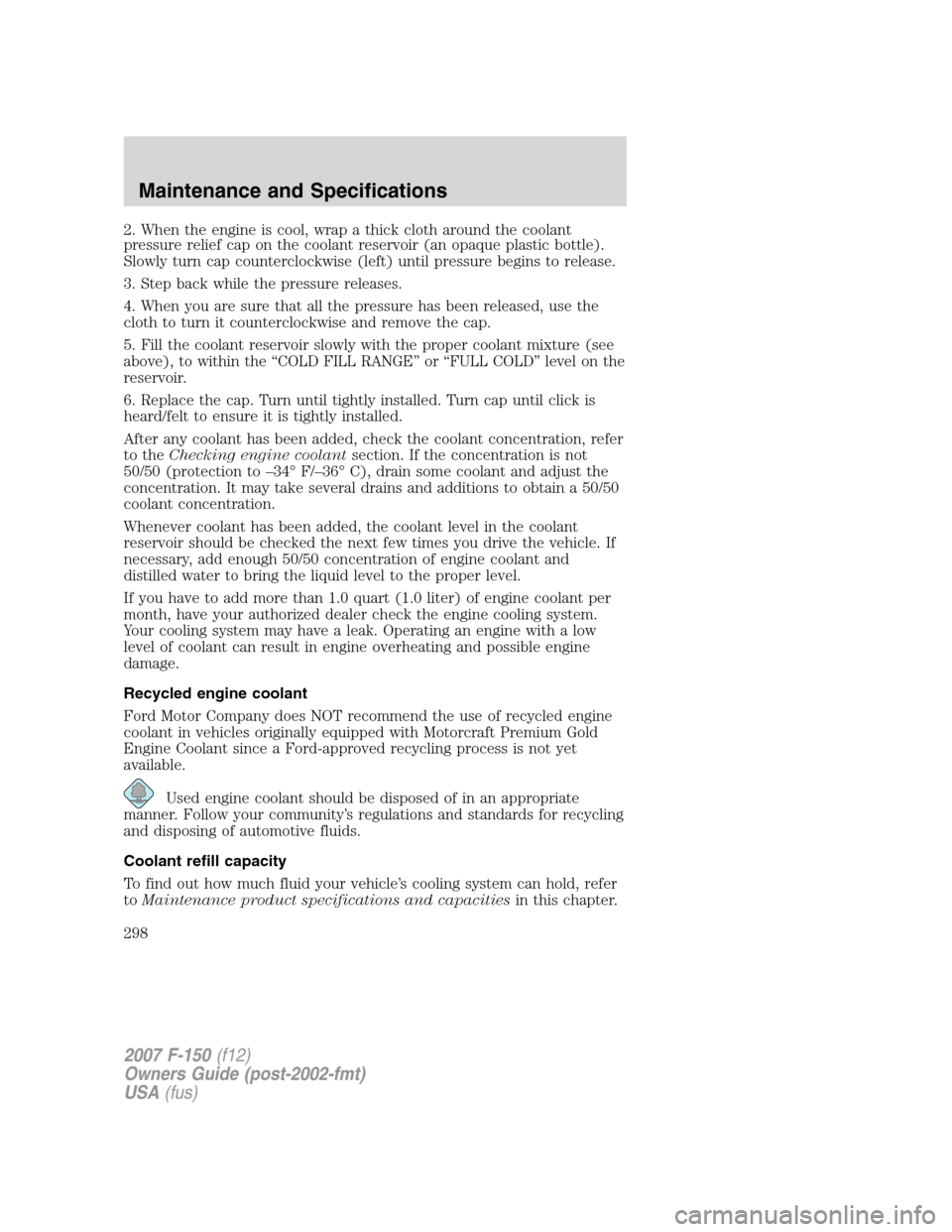2007 FORD F150 heating
[x] Cancel search: heatingPage 212 of 344

If the engine fails to start using the preceding instructions (flexible
fuel vehicles only)
1. Press and hold down the accelerator 1/3 to 1/2 way to floor, then
crank the engine.
2. When the engine starts, release the key, then gradually release the
accelerator pedal as the engine speeds up. If the engine still fails to start,
repeat Step 1.
Guarding against exhaust fumes
Carbon monoxide is present in exhaust fumes. Take precautions to avoid
its dangerous effects.
If you smell exhaust fumes inside your vehicle, have your dealer
inspect your vehicle immediately. Do not drive if you smell
exhaust fumes.
Important ventilating information
If the engine is idling while the vehicle is stopped for a long period of
time, open the windows at least one inch (2.5 cm) or adjust the heating
or air conditioning to bring in fresh air.
ENGINE BLOCK HEATER (IF EQUIPPED)
An engine block heater warms the engine coolant which aids in starting
and heater/defroster performance. Use of an engine block heater is
strongly recommended if you live in a region where temperatures reach
-10°F (-23°C) or below. For best results, plug the heater in at least three
hours before starting the vehicle. The heater can be plugged in the night
before starting the vehicle.
To reduce the risk of electrical shock, do not use your heater
with ungrounded electrical systems or two-pronged (cheater)
adapters.
BRAKES
Occasional brake noise is normal. If a metal-to-metal, continuous grinding
or continuous squeal sound is present, the brake linings may be worn-out
and should be inspected by an authorized dealer. If the vehicle has
continuous vibration or shudder in the steering wheel while braking, the
vehicle should be inspected by an authorized dealer.
2007 F-150(f12)
Owners Guide (post-2002-fmt)
USA(fus)
Driving
212
Page 236 of 344

Driving on hilly or sloping terrain
Although natural obstacles may make it necessary to travel diagonally up
or down a hill or steep incline, you should always try to drive straight up
or straight down.Avoid driving crosswise or turning on steep
slopes or hills. A danger lies in losing traction, slipping sideways and
possibly rolling over. Whenever driving on a hill, determine beforehand
the route you will use. Do not drive over the crest of a hill without
seeing what conditions are on the other side. Do not drive in reverse
over a hill without the aid of an observer.
When climbing a steep slope or hill,
start in a lower gear rather than
downshifting to a lower gear from a
higher gear once the ascent has
started. This reduces strain on the
engine and the possibility of stalling.
If you do stall out, do not try to
turn around because you might roll
over. It is better to back down to a
safe location.
Apply just enough power to the wheels to climb the hill. Too much
power will cause the tires to slip, spin or lose traction, resulting in loss of
vehicle control.
Descend a hill in the same gear you
would use to climb up the hill to
avoid excessive brake application
and brake overheating. Do not
descend in neutral; instead,
disengage overdrive or manually
shift to a lower gear. When
descending a steep hill, avoid
sudden hard braking as you could
lose control. When you brake hard,
the front wheels can’t turn and if
they aren’t turning, you won’t be
able to steer. The front wheels have to be turning in order to steer the
vehicle. Rapid pumping of the brake pedal will help you slow the vehicle
and still maintain steering control.
If your vehicle has anti-lock brakes, apply the brakes steadily. Do not
“pump” the brakes.
2007 F-150(f12)
Owners Guide (post-2002-fmt)
USA(fus)
Driving
236
Page 297 of 344

Do not put engine coolant in the windshield washer fluid
container. If sprayed on the windshield, engine coolant could
make it difficult to see through the windshield.
•Add Motorcraft Premium Gold Engine Coolant or equivalent
meeting Ford specification WSS-M97B51-A1.Refer to
Maintenance product specifications and capacitiesin this chapter.
Note:Use of Motorcraft Cooling System Stop Leak Pellets or an
equivalent product meeting Ford specification WSS-M99B37-B6, may
darken the color of Motorcraft Premium Gold Engine Coolant from
yellow to golden tan.
•Do not add/mix an orange-colored, extended life coolant such
as Motorcraft Specialty Orange Engine Coolant, meeting Ford
specification WSS-M97B44-D, with the factory-filled coolant.
Mixing Motorcraft Specialty Orange Engine Coolant or any
orange-colored extended life product with your factory filled coolant
can result in degraded corrosion protection.
•A large amount of water without engine coolant may be added, in case
of emergency, to reach a vehicle service location. In this instance, the
cooling system must be drained and refilled with a 50/50 mixture of
engine coolant and distilled water as soon as possible. Water alone
(without engine coolant) can cause engine damage from corrosion,
overheating or freezing.
•Do not use alcohol, methanol, brine or any engine coolants
mixed with alcohol or methanol antifreeze (coolant).Alcohol
and other liquids can cause engine damage from overheating or
freezing.
•Do not add extra inhibitors or additives to the coolant.These
can be harmful and compromise the corrosion protection of the engine
coolant.
Add the proper mixture of coolant and water to the “COLD FILL
RANGE” or “FULL COLD” level. Follow these steps to add engine
coolant.
To reduce the risk of personal injury, make sure the engine is
cool before unscrewing the coolant pressure relief cap. The
cooling system is under pressure; steam and hot liquid can come out
forcefully when the cap is loosened slightly.
1. Before you begin, turn the engine off and let it cool.
2007 F-150(f12)
Owners Guide (post-2002-fmt)
USA(fus)
Maintenance and Specifications
297
Page 298 of 344

2. When the engine is cool, wrap a thick cloth around the coolant
pressure relief cap on the coolant reservoir (an opaque plastic bottle).
Slowly turn cap counterclockwise (left) until pressure begins to release.
3. Step back while the pressure releases.
4. When you are sure that all the pressure has been released, use the
cloth to turn it counterclockwise and remove the cap.
5. Fill the coolant reservoir slowly with the proper coolant mixture (see
above), to within the “COLD FILL RANGE” or “FULL COLD” level on the
reservoir.
6. Replace the cap. Turn until tightly installed. Turn cap until click is
heard/felt to ensure it is tightly installed.
After any coolant has been added, check the coolant concentration, refer
to theChecking engine coolantsection. If the concentration is not
50/50 (protection to –34° F/–36° C), drain some coolant and adjust the
concentration. It may take several drains and additions to obtain a 50/50
coolant concentration.
Whenever coolant has been added, the coolant level in the coolant
reservoir should be checked the next few times you drive the vehicle. If
necessary, add enough 50/50 concentration of engine coolant and
distilled water to bring the liquid level to the proper level.
If you have to add more than 1.0 quart (1.0 liter) of engine coolant per
month, have your authorized dealer check the engine cooling system.
Your cooling system may have a leak. Operating an engine with a low
level of coolant can result in engine overheating and possible engine
damage.
Recycled engine coolant
Ford Motor Company does NOT recommend the use of recycled engine
coolant in vehicles originally equipped with Motorcraft Premium Gold
Engine Coolant since a Ford-approved recycling process is not yet
available.
Used engine coolant should be disposed of in an appropriate
manner. Follow your community’s regulations and standards for recycling
and disposing of automotive fluids.
Coolant refill capacity
To find out how much fluid your vehicle’s cooling system can hold, refer
toMaintenance product specifications and capacitiesin this chapter.
2007 F-150(f12)
Owners Guide (post-2002-fmt)
USA(fus)
Maintenance and Specifications
298
Page 317 of 344

You can check the fluid without driving if the ambient temperature is
above 50°F (10°C). However, if fluid is added at this time, an overfill
condition could result when the vehicle reaches normal operating
temperature.
The transmission fluid should be in
this range if at normal operating
temperature (150°F-170°F
[66°C-77°C]).
The transmission fluid should be in
this range if at ambient temperature
(50°F-95°F [10°C-35°C]).
High fluid level
Fluid levels above the safe range
may result in transmission failure.
An overfill condition of transmission
fluid may cause shift and/or
engagement concerns and/or
possible damage.
High fluid levels can be caused by
an overheating condition.
Adjusting automatic transmission fluid levels
Before adding any fluid, make sure the correct type is used. The type of
fluid used is normally indicated on the dipstick. Refer toMaintenance
product specifications and capacitiesin this chapter.
Use of a non-approved automatic transmission fluid may cause
internal transmission component damage.
If necessary, add fluid in 1/2 pint (250 ml) increments through the filler
tube until the level is correct.
FoMoCo COLD5L 3P -7A020- CB
FoMoCo COLD5L 3P -7A020- CB
FoMoCo COLD5L 3P -7A020- CB
2007 F-150(f12)
Owners Guide (post-2002-fmt)
USA(fus)
Maintenance and Specifications
317
Page 335 of 344

washing ....................................273
waxing .....................................273
wheels ......................................274
wiper blades ............................276
Climate control
(see Air conditioning or
Heating) ...........................48, 51, 54
Clock adjust
6-CD in dash .............................35
AM/FM Stereo ...........................27
AM/FM/CD .................................29
Clutch
fluid ..........................................315
operation while driving ..........223
recommended shift speeds ....224
Compass, electronic ..............87, 89
calibration .................................89
set zone adjustment ...........89–90
Console ........................................69
overhead ....................................70
Controls
power seat ...............................117
steering column ........................81
Coolant
checking and adding ..............295
refill capacities ................298, 324
specifications ..........................324
Cruise control
(see Speed control) ....................79
Customer Assistance ................241
Ford Extended Service
Plan ..........................................270
Getting assistance outside the
U.S. and Canada .....................271
Getting roadside assistance ...241
Getting the service you
need .........................................266
Ordering additional owner’s
literature .................................272Utilizing the
Mediation/Arbitration
Program ...................................270
D
Daytime running lamps
(see Lamps) ................................59
Dipstick
automatic transmission
fluid ..........................................316
engine oil .................................289
Driveline universal joint and
slip yoke ....................................320
Driving under special
conditions ..................223, 232, 236
sand .........................................234
snow and ice ...........................237
through water .................235, 238
DVD system .................................47
E
Electronic message center .........89
Emergencies, roadside
jump-starting ..........................259
Emergency Flashers .................243
Emission control system ..........311
Engine ........................................328
cleaning ...................................275
coolant .....................................295
fail-safe cooling .......................299
idle speed control ...................293
lubrication specifications .......324
refill capacities ........................324
service points ..................285–287
starting after a collision .........243
Engine block heater .................212
Engine oil ..................................289
2007 F-150(f12)
Owners Guide (post-2002-fmt)
USA(fus)
Index
335
Page 336 of 344

checking and adding ..............289
dipstick ....................................289
filter, specifications ........292, 322
recommendations ...................292
refill capacities ........................324
specifications ..........................324
Exhaust fumes ..........................212
F
Fail safe cooling ........................299
Flexible Fuel Vehicle (FFV) ....301
Floor mats ...................................97
Fluid capacities .........................324
Foglamps .....................................59
Four-Wheel Drive vehicles .......227
driving off road .......................231
electronic shift ................229–230
indicator light .........................227
lever operated shift ................228
preparing to drive your
vehicle .....................................217
Fuel ............................................301
calculating fuel
economy ............................92, 308
cap ...........................................304
capacity ...................................324
choosing the right fuel ...........305
comparisons with EPA fuel
economy estimates .................311
detergent in fuel .....................306
filling your vehicle with
fuel ...........................301, 304, 308
filter, specifications ........301, 322
fuel pump shut-off switch .....243
improving fuel economy ........308
octane rating ...................306, 328
quality ......................................307
running out of fuel .................307safety information relating to
automotive fuels .....................301
Fuel - flex fuel vehicle
(FFV) .........................301, 305–306
Fuel pump shut-off switch .......243
Fuses ..................................244–245
G
Gas cap (see Fuel cap) ............304
Gas mileage
(see Fuel economy) .................308
Gauges .........................................19
H
Hazard flashers .........................243
Head restraints .................115, 119
Headlamps ...................................58
aiming ........................................60
autolamp system .......................58
bulb specifications ....................63
daytime running lights .............59
flash to pass ..............................59
high beam .................................59
replacing bulbs .........................64
turning on and off ....................58
Heating
heater only system ...................48
heating and air conditioning
system ...........................49, 51, 54
Homelink wireless control
system ..........................................83
Hood ..........................................284
How to get going ........................22
I
Ignition ...............................208, 328
2007 F-150(f12)
Owners Guide (post-2002-fmt)
USA(fus)
Index
336